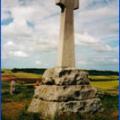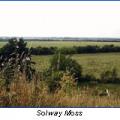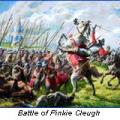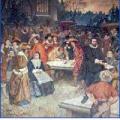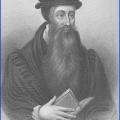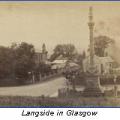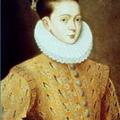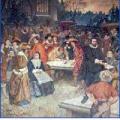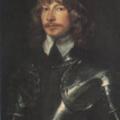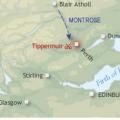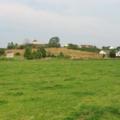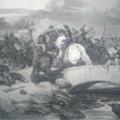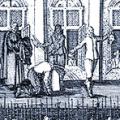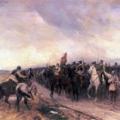Categories
Most Liked
Posted on July 17, 2013
by Amanda Moffet
by Amanda Moffet
Posted on May 12, 2013
by Chas Mac Donald
by Chas Mac Donald
Posted on August 29, 2013
by Amanda Moffet
by Amanda Moffet
Posted on February 6, 2013 by Donald | 3 views | comments
Flodden was a disastrous and unnecessary confrontation for Scotland. James IV of Scotland was married to the sister of England’s King Henry VIII and a treaty of friendship existed between their countries.
The auld alliance between Scotland and France had been recently renewed. There had been Englis...
Posted on February 6, 2013 by Donald | 1 views | comments
Following the success against the English at Haddon Rig in the August, James V gathered an army of ten thousand and sent them, under the command of Oliver Sinclair of Pitcairns, to push as far into England as they could.
Their advance was met at Solway Moss by Sir Thomas Wharton and his three tho...
Posted on February 6, 2013 by Donald | 1 views | comments
Born on 8 December 1542, Mary’s life was complicated from the first week when her father, James V, died and made her Queen when she was six days old.
With James Hamilton, 2nd Earl of Arran, as Governor, Scotland was achieving closer ties with England. Queen Mary was betrothed, in 1543, to Edward,...
Posted on February 6, 2013 by Donald | 2 views | comments
The Battle of Pinkie, on the banks of the River Esk on 10 September 1547, was another catastrophic waste of life encouraged by lack of discipline and weak command.
The Duke of Somerset brought his troops, cavalry and guns to the area, with naval support for his sixteen thousand men having to make...
Posted on February 6, 2013 by Donald | 0 views | comments
A covenant is a contract between God and the people.
In 1557 a group of Protestant nobles opposed to Mary marrying the Roman Catholic Dauphin of France, signed a covenant to state that they would promote the ‘blessed work of God and his Congregation against the Congregation of Satan’, the former...
Posted on February 6, 2013 by Donald | 0 views | comments
The most influential person of the Scottish Reformation, John Knox, was first ordained as a Catholic priest.
Knox spent time in the company of George Wishart before he was arrested and burned for heresy in March 1546 by Cardinal Beaton. Knox joined the Reformers, who murdered Cardinal Beaton the...
Posted on February 6, 2013 by Donald | 0 views | comments
Queen Mary’s reign was in tatters when she escaped from Loch Leven Castle on 2 May 1568. A week later she had gathered six thousand men willing to fight for her as she headed for the safety of her strong Dumbarton Castle, which Lord Fleming was holding for her.
Lord James Stewart, her half-brothe...
Posted on February 6, 2013 by Donald | 1 views | comments
In 1581, Esmé Stewart was created Earl of Lennox.
He was in support of Queen Mary and acknowledged Catholic concerns at a time when the Reformation was well established in Scotland. The Presbyterians believed Lennox to be an agent for the Counter-Reformation and a Catholic spy.
Although both the ...
Posted on February 6, 2013 by Donald | 0 views | comments
Charles I’s views of himself, theology and politics became increasingly contradictory to the beliefs of the Presbyterians. Charles tried to bring together the laws and churches of Scotland and England, with all roads leading to himself.
In 1637 he produced the Book of Common Prayer, written witho...
Posted on February 6, 2013 by Donald | 0 views | comments
James Graham, 5th Earl and later 1st Marquis of Montrose, was born in 1612 and studied at St Andrew’s University.
In 1638 he contributed to the National Covenant, and fought for the Covenant in the Bishops’ Wars. As the country moved into ever more turbulent times, Montrose’s sympathies moved bac...
Posted on February 6, 2013 by Donald | 2 views | comments
In the August of 1644 James Graham, 1st Marquis of Montrose, combined his force of cavalry and Highland foot soldiers with Alasdair MacDonald's Irish soldiers to begin a campaign against the Covenanters for Charles I.
Their first target for reclamation was Perth, and on the 1st September they arr...
Posted on February 6, 2013 by Donald | 0 views | comments
Under James Graham, the Marquis of Montrose, the Royalist army had achieved success at Inverlochy and Dundee.
He made camp with his 1750 men and 250 horses at Auldearn, around three miles to the east of Nairn. The Covenanters were marching through the night from Inverness to fight him.
Sir John ...
Posted on February 6, 2013 by Donald | 1 views | comments
On Philiphaugh a fray began
At Hairhead wood it ended;
The Scots out o'er the Graemes, they ran,
See merrily they bended.
Sir David frae the Border came,
Wi' heart an' hand came he;
Wi' him three thousand bonny Scots,
To bear him company.
Traditional Border Ballad
The Marquis of Montrose had co...
Posted on February 6, 2013 by Donald | 0 views | comments
Civil War had begun in earnest by 1642. Charles I was the enemy of the Presbyterians in Scotland and the parliamentarians in England.
His lack of ability at negotiation and conciliation had compounded his situation. Montrose had done well for him in undermining the Calvinists and Campbells for a ...
Posted on February 6, 2013 by Donald | 2 views | comments
The Calvinists were in support of Charles II when he became King and signed both the Covenants in 1649. Cromwell, however, was not. With sixteen thousand men he invaded Scotland in July and headed for Edinburgh, expecting to rendezvous with his supply ships at Leith. David Leslie and the Scots arm...
Featured Articles
Most Discussed
Posted on July 16, 2013
by Amanda Moffet
by Amanda Moffet
Posted on February 6, 2013
by Donald
by Donald
Posted on July 17, 2013
by Amanda Moffet
by Amanda Moffet


 View More
View More View Less
View Less